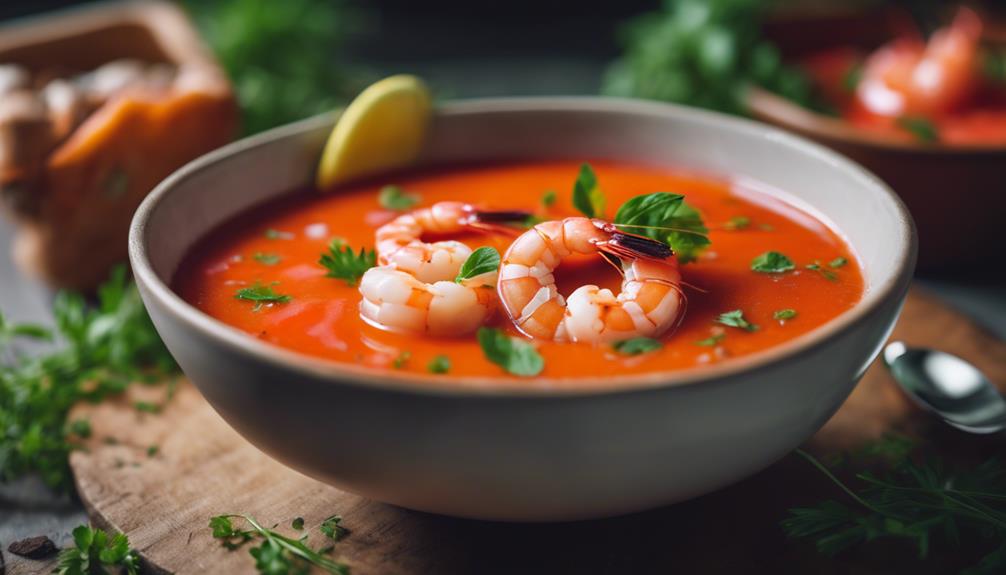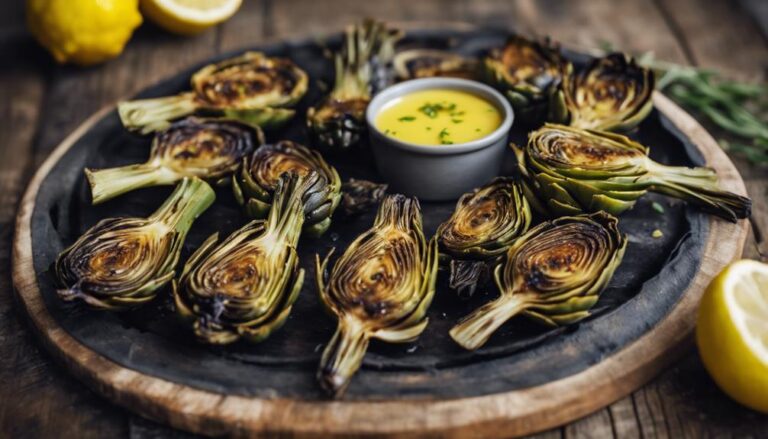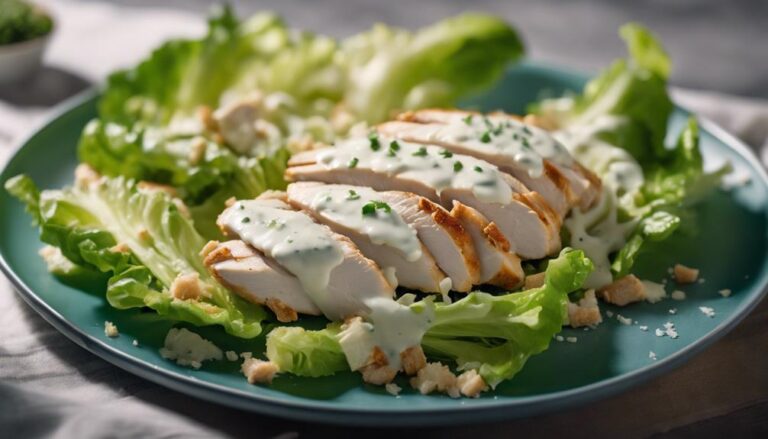Chilled Gazpacho With Sous Vide Shrimp
Immerse yourself in the delight of chilled gazpacho paired with tender sous vide shrimp. This cool summer dish brings together the invigorating soup's flavors with succulent shrimp, offering a harmonious blend for your taste buds. The gazpacho's blend of ripe tomatoes, cucumbers, garlic, and peppers creates a flavorful base, perfectly complementing the sous vide shrimp. If you want to uncover more about enhancing this dish, keep exploring the distinctive ingredients, chilling techniques, and serving suggestions that will take your culinary experience to the next level.
What You Will Learn Here
- Sous vide shrimp adds a tender texture and enhances the flavor of chilled gazpacho.
- The sous vide method ensures precise cooking and juicy shrimp for a perfect pairing.
- Gazpacho's refreshing nature complements the lightness of sous vide shrimp.
- The combination offers a sophisticated and elegant twist to a classic dish.
- Serve chilled gazpacho with sous vide shrimp for a revitalizing summer meal.
Gazpacho's Origins
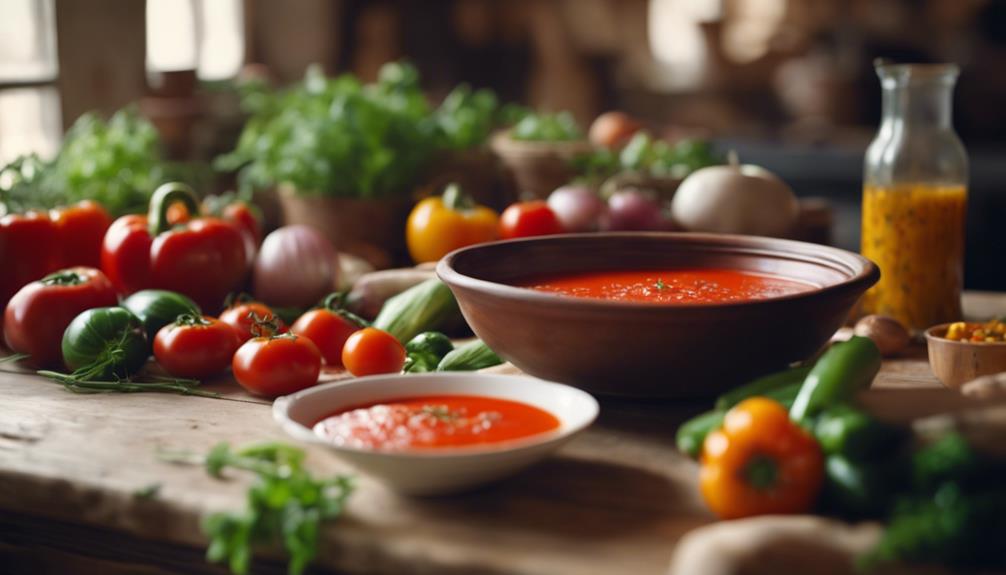
Gazpacho, a cold soup typically made from tomatoes and other vegetables, has deep historical roots in Andalusia, Spain.
Over the years, this invigorating dish has evolved, incorporating various regional ingredients and preparation methods.
Understanding the cultural significance of gazpacho sheds light on its journey from a humble peasant dish to a beloved culinary delight enjoyed worldwide.
Gazpacho's Historical Roots
Originally believed to have roots in the Andalusian region of Spain, the origins of gazpacho can be traced back to ancient Roman times. With a strong Spanish influence, gazpacho has become a quintessential summer tradition, known for its invigorating qualities and vibrant flavors. The Andalusian roots of this chilled soup play a significant role in its culinary history, shaping the ingredients and preparation methods that have stood the test of time.
Gazpacho's evolution from its Roman origins to the present day showcases the adaptability and creativity of Spanish cuisine. The warm climate of southern Spain, particularly in Andalusia, contributed to the development of this cold soup as a way to combat the heat while utilizing the region's abundant harvest of fresh vegetables.
As gazpacho continues to be enjoyed worldwide, its historical roots remind us of the rich culinary heritage behind this simple yet flavorful dish. Embracing the essence of summer in every spoonful, gazpacho stands as a tribute to the enduring traditions of Andalusian gastronomy.
Evolution of Gazpacho
Tracing the culinary journey of gazpacho reveals the intricate evolution of this invigorating dish. Originating in the Andalusian region of Spain, gazpacho has undergone significant evolutionary trends over the centuries. Initially a simple blend of bread, olive oil, vinegar, water, and garlic pounded together, gazpacho has transformed into a chilled tomato-based soup incorporating ingredients like peppers, cucumbers, and onions.
The modern adaptations of gazpacho showcase a fusion of traditional and contemporary culinary influences. Chefs worldwide have put their spin on the classic recipe, incorporating new ingredients and techniques to create unique variations. While the traditional gazpacho recipe remains a staple, evolutionary trends have led to innovative versions such as fruit-infused gazpachos or creamy avocado-based renditions.
The evolution of gazpacho reflects the dynamic nature of gastronomy, where recipes adapt to changing tastes and culinary practices. Embracing both tradition and innovation, gazpacho continues to captivate palates around the globe with its invigorating flavors and versatility.
Cultural Significance of Gazpacho
Amidst the rich tapestry of Spanish culinary history, the cultural significance of gazpacho reveals a story steeped in tradition and flavor. Gazpacho, a cold soup originating from Andalusia in southern Spain, is a reflection of cultural traditions that have been passed down through generations. This iconic dish embodies the essence of Spanish cuisine, with its vibrant colors and invigorating taste that are perfect for warm summer days.
The flavor profiles of gazpacho are a confirmation to the fresh ingredients used in its preparation. Tomatoes, peppers, cucumbers, onions, and garlic come together to create a harmonious blend of sweet, tangy, and savory notes. The use of olive oil and vinegar adds depth and richness to the soup, while a hint of bread provides texture and body. These flavors combine to produce a dish that's both simple yet bursting with complexity, showcasing the culinary expertise of Spanish cooks throughout history.
Gazpacho's cultural significance lies not only in its taste but also in the way it embodies the spirit of Spanish gastronomy, making it a beloved symbol of the country's culinary heritage.
Key Ingredients to Enhance Flavor
To enhance the flavor of your chilled gazpacho with sous vide shrimp, carefully select key ingredients that complement each other harmoniously. When considering flavor combinations and ingredient pairing, keep in mind these essential elements:
- Ripe Tomatoes: Opt for ripe, juicy tomatoes to provide a sweet and tangy base for your gazpacho. The quality of tomatoes greatly impacts the overall taste of the dish.
- Fresh Cucumbers: Crisp and invigorating, cucumbers add a coolness to the gazpacho while enhancing its texture. Choose firm cucumbers with vibrant green skin.
- Garlic: Aromatic and pungent, garlic infuses the gazpacho with a savory depth of flavor. Use it judiciously to avoid overpowering the other ingredients.
- Bell Peppers: Vibrant and slightly sweet, bell peppers contribute a subtle sweetness and a pop of color to the gazpacho. Select red, yellow, or orange peppers for a visually appealing presentation.
Chilled Gazpacho Variations
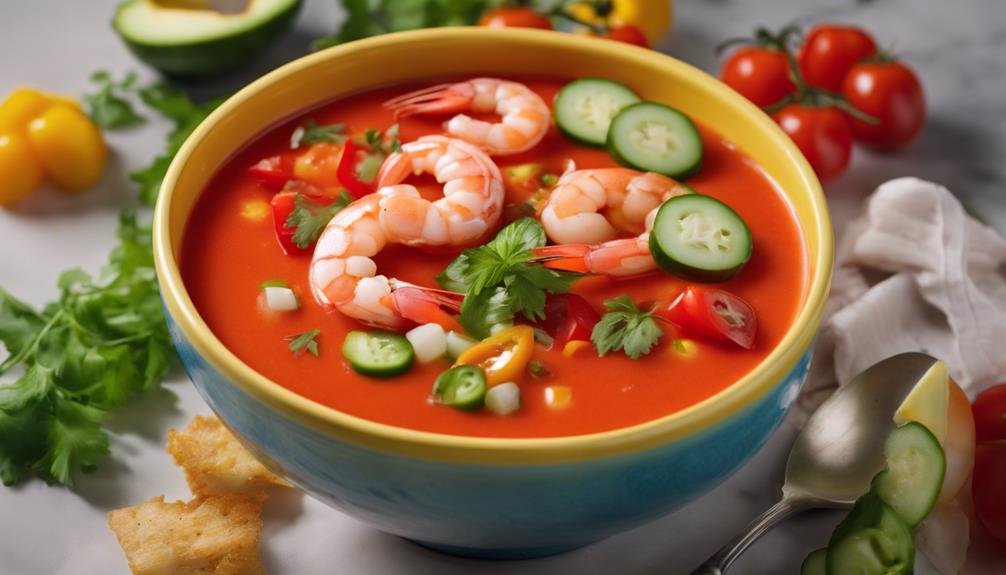
Explore exciting variations of chilled gazpacho to elevate your culinary experience.
Try the zesty tomato gazpacho for a classic twist, or opt for the invigorating shrimp and avocado gazpacho for a unique flavor combination.
For a fruity and light option, consider whipping up the chilled watermelon gazpacho recipe.
Zesty Tomato Gazpacho Recipe
For an invigorating twist on traditional gazpacho, consider trying out a zesty tomato gazpacho recipe. This revitalizing dish is perfect for warm summer days and is easy to make.
Here are some tips to enhance your zesty tomato gazpacho:
- Spicy Kick: Add a dash of hot sauce or a sprinkle of cayenne pepper to give your gazpacho a spicy kick.
- Herb Infusion: Incorporate fresh herbs like basil or cilantro for added flavor and freshness.
- Citrus Zing: Squeeze some lemon or lime juice into the gazpacho for a citrusy zing that brightens up the dish.
- Crunchy Texture: Top your gazpacho with diced cucumbers or bell peppers for a crunchy texture that contrasts with the smooth soup.
When serving your zesty tomato gazpacho, consider garnishing with a drizzle of olive oil, a dollop of sour cream, or a sprinkle of chopped herbs for added visual appeal. This chilled soup pairs well with crusty bread, a side salad, or even grilled shrimp for a satisfying meal.
Enjoy the burst of flavors in every spoonful!
Shrimp and Avocado Gazpacho
Consider trying out an invigorating twist on traditional gazpacho with a delightful combination of shrimp and avocado in this chilled variation. The creamy texture of the avocado pairs perfectly with the succulent sous vide-prepared shrimp, adding a rich and satisfying element to the dish. Here are some key points to keep in mind when preparing this invigorating Shrimp and Avocado Gazpacho:
- Fresh Ingredients: Use ripe avocados and high-quality shrimp for the best flavor.
- Balanced Seasoning: Season the gazpacho generously with salt and a hint of lime juice to enhance the flavors.
- Chilling Time: Allow the gazpacho to chill in the refrigerator for a few hours before serving to let the flavors meld together.
- Garnish Creatively: Consider topping your gazpacho with additional shrimp, diced avocado, or a drizzle of olive oil for an elegant presentation.
This variation of gazpacho offers a unique and satisfying twist on the classic recipe, perfect for a light and invigorating meal on a warm day.
Chilled Watermelon Gazpacho Recipe
To create an invigorating twist on traditional gazpacho, try preparing a Chilled Watermelon Gazpacho Recipe using ripe watermelon and crisp cucumbers for a burst of summer flavors.
- Blend Ingredients: Combine juicy watermelon chunks, revitalizing cucumber slices, tangy tomatoes, and a hint of red onion in a blender until smooth.
- Chill Thoroughly: Refrigerate the gazpacho for at least an hour to enhance the flavors and make sure it's wonderfully cold.
- Garnish Creatively: Serve the chilled watermelon gazpacho in elegant bowls and top with a drizzle of olive oil, a sprinkle of fresh herbs, and a dash of black pepper.
- Enjoy with Sous Vide Shrimp: Pair this invigorating summer dish with perfectly cooked sous vide shrimp for a delightful contrast of temperatures and textures.
Watermelon gazpacho offers a delightful combination of sweet and savory flavors, making it a perfect choice for a light summer meal. When served alongside succulent sous vide shrimp, the dish becomes a harmonious blend of freshness and sophistication.
Chilling Techniques
To guarantee your gazpacho reaches the ideal chilled consistency, you can explore various techniques. Quick methods like placing the soup in an ice bath or utilizing refrigeration can speed up the chilling process.
These approaches will help you achieve that invigorating temperature for your gazpacho quickly and efficiently.
Quick Chilling Methods
For rapid chilling, immerse your container of gazpacho in an ice bath. If you're short on time, there are a few quick methods you can use to chill your gazpacho efficiently.
One method is the ice cube method. Simply add a handful of ice cubes into the gazpacho and stir gently. The ice cubes will help guarantee lower the temperature rapidly, cooling your gazpacho in no time.
Another quick chilling method is the freezer method. Pour your gazpacho into a shallow, freezer-safe container. Place the container in the freezer for about 30 minutes, making sure to stir the gazpacho every 10 minutes to assure even cooling. Be cautious not to leave it in for too long, as you don't want it to freeze completely.
These quick chilling methods are handy when you're in a hurry and need your gazpacho chilled promptly. Experiment with these techniques to find the one that works best for you.
Ice Bath Technique
Using an ice bath is a quick and efficient technique for chilling gazpacho rapidly. This method involves placing the container of gazpacho in a larger bowl filled with ice and water. The ice bath rapidly lowers the temperature of the gazpacho, guaranteeing it reaches a safe temperature for storage or serving. When chilling gazpacho with the ice bath technique, it's crucial to stir the soup occasionally to promote even cooling.
Sous vide benefits extend to temperature control techniques like the ice bath method. By quickly cooling gazpacho after it has been cooked or prepared, you can preserve the flavors and textures of the ingredients. This is especially important for dishes like chilled gazpacho, where the freshness and vibrancy of the vegetables are key to the overall taste.
When using the ice bath technique in combination with sous vide cooking, you can make sure that your gazpacho stays fresh and delicious, ready to be served alongside perfectly cooked sous vide shrimp.
Refrigeration Tips
Consider storing gazpacho in the refrigerator for at least an hour before serving to enhance its flavors and allow the ingredients to meld together. This step not only chills the gazpacho to a cool temperature but also helps intensify the taste. When refrigerating your gazpacho, make sure it's in an airtight container to prevent any contamination and maintain food safety standards.
For best results, place the gazpacho in the coldest part of your refrigerator. This will help it cool faster and maintain its freshness. Remember to consume the gazpacho within a few days to ensure quality and food safety.
If you find yourself with leftover gazpacho that you want to preserve for a longer duration, consider freezing it. Freezing options can vary from using freezer-safe containers to ice cube trays for convenient portioning. Just be aware that freezing can alter the texture slightly, so it's best to consume the gazpacho within a few months for the best taste.
Final Thoughts
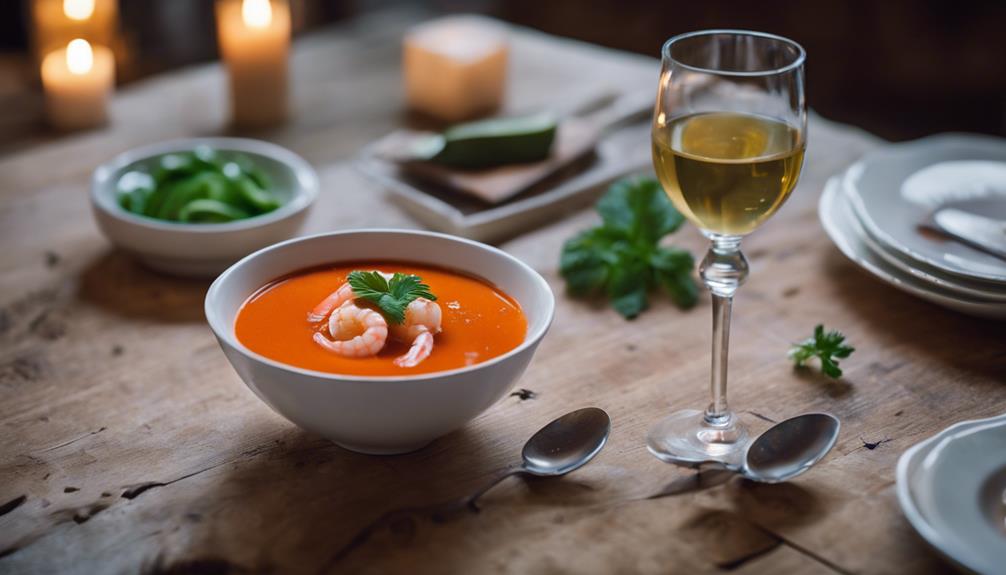
Reflect on the overall experience and savor the delightful combination of flavors in this invigorating dish. The chilled gazpacho with sous vide shrimp offers a revitalizing and light option for a summer meal. For food pairings, consider serving this gazpacho alongside a crisp white wine like a Sauvignon Blanc or a light rosé to complement the fresh flavors of the dish. The acidity in the wine will balance well with the tanginess of the gazpacho.
When it comes to serving presentation, consider garnishing the gazpacho with a drizzle of high-quality olive oil, a sprinkle of fresh herbs like basil or parsley, and a few additional shrimp placed neatly on top. This won't only enhance the visual appeal of the dish but also add extra layers of flavor and texture.
Frequently Asked Questions
Can I Substitute Shrimp With Another Protein in This Recipe?
When making this dish, feel free to swap out shrimp for alternative proteins like chicken, tofu, or crab. Experiment with flavor options to create a unique twist that suits your taste preferences. Enjoy your culinary adventure!
How Long Can I Store Leftover Gazpacho in the Refrigerator?
You can store leftover gazpacho in the refrigerator for up to 3-4 days for best food safety. Get creative by using it as a base for other recipes or enjoy it with a different protein for a tasty twist.
Are There Any Vegetarian Alternatives for the Shrimp Topping?
For vegan options or meat alternatives as toppings, consider marinated tofu cubes, grilled portobello mushrooms, or seasoned seitan strips. These choices offer tasty alternatives to shrimp, adding texture and flavor to your dish.
Can I Add Alcohol, Like Vodka, to the Gazpacho for Flavor?
Yes, you can add vodka to the gazpacho for an alcohol infusion and a flavor enhancement. It's a great way to experiment with taste and give your gazpacho a vodka twist. Just remember to adjust the overall seasoning accordingly.
Is It Possible to Freeze Gazpacho for Later Consumption?
Yes, you can freeze gazpacho for later consumption, but be aware that freezing might alter its taste slightly. It's a great way to extend its shelf life while maintaining food safety. Just give it a good stir after thawing.
Conclusion
To sum up, chilled gazpacho with sous vide shrimp is a rejuvenating and flavorful dish that combines the vibrant flavors of summer vegetables with perfectly cooked shrimp.
By understanding the origins of gazpacho, key ingredients, and chilling techniques, you can create a delicious variation of this classic soup.
Whether you enjoy it as a light lunch or a revitalizing appetizer, this dish is sure to impress with its unique flavors and textures.
Try making it at home and enjoy a taste of summer anytime.
